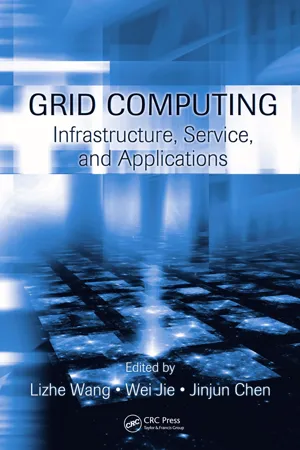
- 528 pages
- English
- ePUB (mobile friendly)
- Available on iOS & Android
About this book
Identifies Recent Technological Developments Worldwide
The field of grid computing has made rapid progress in the past few years, evolving and developing in almost all areas, including concepts, philosophy, methodology, and usages. Grid Computing: Infrastructure, Service, and Applications reflects the recent advances in this field, covering the research aspects that involve infrastructure, middleware, architecture, services, and applications.
Grid Systems Across the Globe
The first section of the book focuses on infrastructure and middleware and presents several national and international grid systems. The text highlights China Research and Development environment Over Wide-area Network (CROWN), several ongoing cyberinfrastructure efforts in New York State, and Enabling Grids for E-sciencE (EGEE), which is co-funded by the European Commission and the world's largest multidisciplinary grid infrastructure today.
The second part of the book discusses recent grid service advances. The authors examine the UK National Grid Service (NGS), the concept of resource allocation in a grid environment, OMIIBPEL, and the possibility of treating scientific workflow issues using techniques from the data stream community. The book describes an SLA model, reviews portal and workflow technologies, presents an overview of PKIs and their limitations, and introduces PIndex, a peer-to-peer model for grid information services.
New Projects and Initiatives
The third section includes an analysis of innovative grid applications. Topics covered include the WISDOM initiative, incorporating flow-level networking models into grid simulators, system-level virtualization, grid usage in the high-energy physics environment in the LHC project, and the Service Oriented HLA RTI (SOHR) framework.
With a comprehensive summary of past advances, this text is a window into the future of this nascent technology, forging a path for the next generation of cyberinfrastructure developers.
Frequently asked questions
- Essential is ideal for learners and professionals who enjoy exploring a wide range of subjects. Access the Essential Library with 800,000+ trusted titles and best-sellers across business, personal growth, and the humanities. Includes unlimited reading time and Standard Read Aloud voice.
- Complete: Perfect for advanced learners and researchers needing full, unrestricted access. Unlock 1.4M+ books across hundreds of subjects, including academic and specialized titles. The Complete Plan also includes advanced features like Premium Read Aloud and Research Assistant.
Please note we cannot support devices running on iOS 13 and Android 7 or earlier. Learn more about using the app.
Information
Part I
Grid Infrastructure and Middleware
1
CROWN: A Service Grid Middleware for e-Science
CONTENTS
1.1 Background
1.2 CROWN Middleware
1.2.1 Design Motivation
Table of contents
- Cover
- Half Title
- Title Page
- Copyright Page
- Table of Contents
- Foreword
- Preface
- Contributors
- Part I: Grid Infrastructure and Middleware
- Part II: Grid Services
- Part III: Grid Applications
- Index